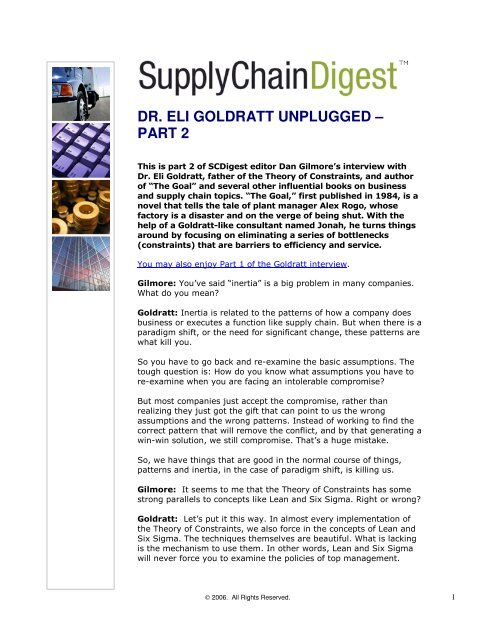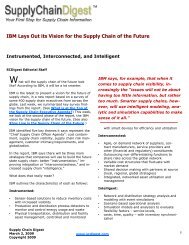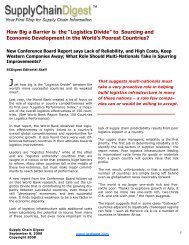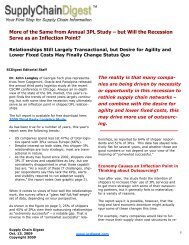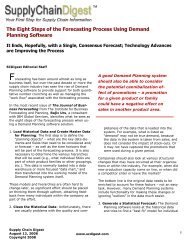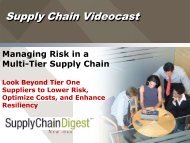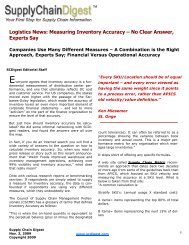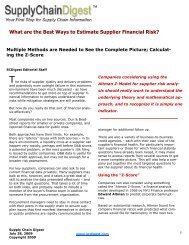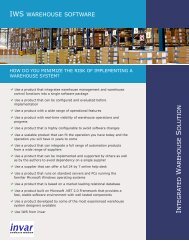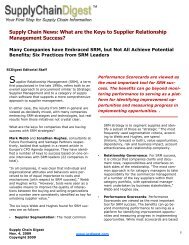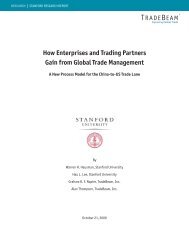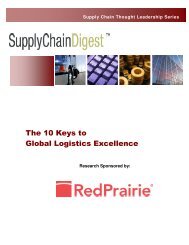DR. ELI GOLDRATT UNPLUGGED – PART 2 - Supply Chain Digest
DR. ELI GOLDRATT UNPLUGGED – PART 2 - Supply Chain Digest
DR. ELI GOLDRATT UNPLUGGED – PART 2 - Supply Chain Digest
Create successful ePaper yourself
Turn your PDF publications into a flip-book with our unique Google optimized e-Paper software.
<strong>DR</strong>. <strong>ELI</strong> GOL<strong>DR</strong>ATT <strong>UNPLUGGED</strong> <strong>–</strong><br />
<strong>PART</strong> 2<br />
This is part 2 of SC<strong>Digest</strong> editor Dan Gilmore’s interview with<br />
Dr. Eli Goldratt, father of the Theory of Constraints, and author<br />
of “The Goal” and several other influential books on business<br />
and supply chain topics. “The Goal,” first published in 1984, is a<br />
novel that tells the tale of plant manager Alex Rogo, whose<br />
factory is a disaster and on the verge of being shut. With the<br />
help of a Goldratt-like consultant named Jonah, he turns things<br />
around by focusing on eliminating a series of bottlenecks<br />
(constraints) that are barriers to efficiency and service.<br />
You may also enjoy Part 1 of the Goldratt interview.<br />
Gilmore: You’ve said “inertia” is a big problem in many companies.<br />
What do you mean?<br />
Goldratt: Inertia is related to the patterns of how a company does<br />
business or executes a function like supply chain. But when there is a<br />
paradigm shift, or the need for significant change, these patterns are<br />
what kill you.<br />
So you have to go back and re-examine the basic assumptions. The<br />
tough question is: How do you know what assumptions you have to<br />
re-examine when you are facing an intolerable compromise?<br />
But most companies just accept the compromise, rather than<br />
realizing they just got the gift that can point to us the wrong<br />
assumptions and the wrong patterns. Instead of working to find the<br />
correct pattern that will remove the conflict, and by that generating a<br />
win-win solution, we still compromise. That’s a huge mistake.<br />
So, we have things that are good in the normal course of things,<br />
patterns and inertia, in the case of paradigm shift, is killing us.<br />
Gilmore: It seems to me that the Theory of Constraints has some<br />
strong parallels to concepts like Lean and Six Sigma. Right or wrong?<br />
Goldratt: Let’s put it this way. In almost every implementation of<br />
the Theory of Constraints, we also force in the concepts of Lean and<br />
Six Sigma. The techniques themselves are beautiful. What is lacking<br />
is the mechanism to use them. In other words, Lean and Six Sigma<br />
will never force you to examine the policies of top management.<br />
© 2006. All Rights Reserved. 1
And that’s why they have a limited effect. Once you have used Theory of Constraints<br />
at a higher level to really understand what you need to do, at a lower level these<br />
techniques are fantastic. But you need to know where to use them and where not.<br />
For example, the U.S. Navy has an RFP last year for all its logistics operations, a<br />
huge undertaking. In the RFP, they said the umbrella for the operator must be<br />
Theory of Constraints, and underneath that Lean. That’s exactly what I am saying.<br />
Gilmore: When you are working with companies, what is typically the “Aha”<br />
moment, when the light bulb finally goes off?<br />
Goldratt: If you really want an answer to that, I am<br />
going to have to market myself. Let’s look at “The Goal.’<br />
In that book, the consultant, Jonah, leads Alex Rogo step<br />
by step down the path, almost by the nose. I am actually<br />
sick of that approach.<br />
That book focused at the plant level. My assumption was<br />
that if I showed top management the whole thing up<br />
front, they’d say “It’s unrealistic,” We’re different,” all<br />
the usual things, and they will not move.<br />
If Jonah would have<br />
told Alex in “The Goal”<br />
what the performance<br />
of the factory really<br />
should be a year or so<br />
down the road, Alex<br />
would have fainted.<br />
Even at a more local level, it can be hard. If Jonah would have told Alex in “The<br />
Goal” what the performance of the factory really should be a year or so down the<br />
road, Alex would have fainted.<br />
And this is the problem. You go into a company, you use Theory of Constraints to<br />
make progress, move someone one step then another, they get fat and happy again,<br />
and then they just want to stop. But you’ve just started!<br />
So <strong>–</strong> this is the marketing part <strong>–</strong> I’ve started with a new thing called “Viable Vision,”<br />
where I am showing company execs the whole thing for the first four years. And<br />
again, I tell most of them that in four years they can have net profit equal to their<br />
current total sales.<br />
Of course, the first reaction is “This is totally unrealistic,” but then we say back,<br />
“Give us the data, and we’ll show you how to do it.” We show them how to do it,<br />
and then we take on the implementation plan.<br />
Gilmore: Net profit in four years equal to current sales?<br />
Goldratt: That’s right. Not every company. Right now, I know how to do it with<br />
about 80% of them.<br />
Gilmore: What’s the barrier at the other 20%?<br />
Goldratt: I’m stupid <strong>–</strong> I don’t know enough yet. I am restricting myself now, for<br />
example, to physical products. Not hospitals, banks, etc., even though we know in<br />
general Theory of Constraints works beautifully there, but we have less data and<br />
don’t want to take on too big a risk because all of our contracts are based almost<br />
totally on realizing the results.<br />
Goldratt Interview Part 2 © 2006. All Rights Reserved. 2
Gilmore: When you look at the issues and plans across companies after you do this<br />
analysis, what are common themes or opportunities?<br />
Goldratt: Let me give you the truth. In order to minimize risk and best enable my<br />
people to execute this, I have eight generic solutions. If it fits one of these eight, we<br />
take the project. If it doesn’t, we don’t.<br />
Those eight templates cover 80% of the physical products companies, including<br />
manufacturers, retailers, wholesalers, etc.<br />
Gilmore: Can you describe a common<br />
template?<br />
Goldratt: Well, to do this in half a page or<br />
whatever this will be will probably be mumbojumbo,<br />
but fine.<br />
Suppose that we are producing manufactured<br />
products that are sold through distribution,<br />
wholesale and retail, ok?<br />
It doesn’t matter to me that in<br />
general they order from you<br />
once a week. What I want to<br />
know is for each specific<br />
product how frequently they<br />
order. And if the answer is<br />
they order once in two weeks<br />
or more than two weeks,<br />
that’s it - I have the solution.<br />
Then the question the question I am really interested in is “How frequently those<br />
channels are ordering from you the same SKU?” It doesn’t matter to me that in<br />
general they order from you once a week. What I want to know is for each specific<br />
product how frequently they order. And if the answer is they order once in two<br />
weeks or more than two weeks, that’s it - I have the solution.<br />
Because what happens is that if say they are ordering the same product once a<br />
month, that means the total order lead time <strong>–</strong> from when the sell a unit to when<br />
they order a unit <strong>–</strong> is one month. This is enough to kill them.<br />
It will typically create big problems with excess inventory, along with frequent<br />
problems with unavailability. So now, the standard solution shows them how to do<br />
this with less than half the inventory, with almost no unavailability.<br />
Do you understand once you are doing that you are taking the market?<br />
A retailer or wholesaler’s key metric is inventory turns, and its main concern<br />
unavailability. If you solve both these problems, that’s it, the customer is yours.<br />
Gilmore: Ok, I think the basic issue is well understood. We’ve been trying to solve<br />
that with many things, from collaborative planning to RFID and lots of other<br />
technologies and strategies.<br />
Goldratt: These are all hard. This solution is so damn simple.<br />
Do you know that I have put in the public domain computer courses? Because I<br />
found that in a manager wants to get buy-in from his people, a computer course is<br />
far more effective than a book. Exactly what I have told you about how to do that<br />
solution is in one of the computer courses.<br />
Goldratt Interview Part 2 © 2006. All Rights Reserved. 3
Gilmore: Procter & Gamble is among the companies trying to solve this, and is<br />
doing so in part by trying to make their factories more flexible to shorten the length<br />
of production runs and enable more SKUs to be made each day….<br />
Goldratt: First, so you know, the Procter & Gamble soap and detergents division<br />
implemented my distribution solution in 1989! But it as just that division, as far as I<br />
know.<br />
Gilmore: Procter & Gamble is of course better than most, but they are committed to<br />
this further improvement, though whether the manufacturing economics will allow<br />
them to make tubes of Crest or whatever in much shorter runs, as even they have<br />
said, remains to be seen.<br />
Goldratt: But at the same time I think you’d<br />
find the P&G or at least most consumer goods<br />
manufacturers give big discounts to retailers<br />
and wholesalers for ordering in large quantities.<br />
That’s part of what kills them all. If they would<br />
refrain from that, then they probably wouldn’t<br />
need to make their plants more flexible.<br />
Let’s consider an example. You are a shop. And<br />
let’s say I say to you, you have to buy minimum<br />
of 100. And you are selling two per day, on<br />
average. So immediately I have elongated your<br />
cycle by 50 days. Because now you will wait to<br />
So save two cents there so<br />
you can pay 20 cents over<br />
here. Very smart. Let small<br />
warehouse concerns override<br />
smart business decisions.<br />
Think about what you’ve just<br />
said. Rather than pick a carton<br />
or two instead of a full pallet<br />
and have a few more pennies<br />
of warehouse cost, I need to<br />
invest in flexible plants?<br />
order until you have run down the first 100 and then order another 100. I have put<br />
into the replenishment time 50 days.<br />
Gilmore: The response, I would think, is that there are trade-offs between inventory<br />
and transportation, and my costs of shipping the two I sold that day are way too<br />
high.<br />
Goldratt: Since when are we allowed to put only one type of product in a truck? So,<br />
where is this argument coming from?<br />
Gilmore: Let’s take it back further then. It costs a lot more per unit to pick and ship<br />
say two items than a pallet of them.<br />
Goldratt: Your right <strong>–</strong> so save two cents there so you can pay 20 cents over here.<br />
Very smart. Let small warehouse concerns override smart business decisions. Think<br />
about what you’ve just said. Rather than pick a carton or two instead of a full pallet<br />
and have a few more pennies of warehouse cost, I need to invest in flexible plants?<br />
Gilmore: Well, part of the issue of course is that most companies in the end are still<br />
siloed, and the distribution director is in fact primarily concerned with DC operational<br />
efficiency, and transportation managers their metrics, etc.<br />
Goldratt: No you understand why in the Theory of Constraints that the number one<br />
thing we attack all the time is called “Local Optima.” Someone tries to optimize a<br />
piece of the system, and you kill the system. That’s why again we now focus up front<br />
on viewing the whole picture.<br />
Goldratt Interview Part 2 © 2006. All Rights Reserved. 4
Gilmore: People and companies have taken the Theory of Constraints and taken it in<br />
all kinds of different directions. Are they doing this well, or is it being misapplied?<br />
Goldratt: I would say most of them are valid.<br />
Gilmore: Some software vendors have adopted at least in part a Theory of<br />
Constraints orientation, especially in “optimization” products. What is the role of<br />
software in TOC?<br />
Goldratt: It depends. There are in fact cases where I don’t know how to solve a<br />
company’s issues without the software. For example, if you are dealing with large<br />
distribution networks of course you have to have the software. You’ll get killed trying<br />
to do it on spreadsheets. You also need software for big project management<br />
activities.<br />
Gilmore: Let’s talk about manufacturing in Europe and North America. There is a lot<br />
of general concern and political heat around “saving” manufacturing in the west,<br />
amidst low costs and pressure from China and other low cost countries. Can adoption<br />
of Theory of Constraints principles help revitalize those manufacturing companies?<br />
Goldratt: I think that question doesn’t consider what is really going on. What is this<br />
“save western manufacturing?” Let me talk about China and India <strong>–</strong> these are the<br />
two you are afraid or, right?<br />
I work a lot in China. You know the biggest problem in China is right now? Getting<br />
people <strong>–</strong> for the 2 nd shift. Can you imagine not enough people in China? Salaries are<br />
now skyrocketing. Statistics say that in 2004 salaries rose by 24%. When they are<br />
finalized in 2005, it will be much higher.<br />
Have you been in Shanghai, for example? You may have had images like I had of<br />
rickshaws and bicycles <strong>–</strong> No! This is a western town. With the best cars everywhere,<br />
and fewer bicycles than in Holland. I sent an assistant to go and look in some shops<br />
for bargains. She said, “Sorry Eli, the prices are the same as in Amsterdam.”<br />
So, China is not only becoming a big producer, but a huge consumer. If what we see<br />
now continues another 5-6 years, China will be by then the largest consumer market<br />
in the world.<br />
What’s happening in India is even more fascinating. I can say without blinking an<br />
eye that in India they have the best management of companies in the world. Better<br />
on average than I have seen in Europe of the United States. There problem was that<br />
they had put chains on themselves, in terms of regulations, tariffs, etc. This is gone.<br />
Because of it, the biggest boom is happening. India is also growing at 8-10 percent<br />
per year, and salaries are also rising rapidly. So again, in just a few years you will<br />
see a huge consumption market.<br />
Do you understand what together this means? In a few years, we will triple the world<br />
consumption in 5 to 6 years. You will see supply chain bottlenecks everywhere in the<br />
world. The best thing that ever happened to us is what is happening now in China<br />
and India. It is time to stop complaining about Chinese producers and focus on how<br />
to enter the Chinese market or export to China and India. What huge, beautiful<br />
markets.<br />
Goldratt Interview Part 2 © 2006. All Rights Reserved. 5
Gilmore: Yes, if they continue to open their markets….<br />
Goldratt: They are open right now. Fine, it still takes 3-4 months of bureaucracy <strong>–</strong><br />
what’s the big deal? As if there is no bureaucracy to overcome in Europe or the U.S.<br />
China and India shouldn’t be looked on as a threat but as a fantastic opportunity.<br />
Gilmore: Our audience is a supply chain<br />
audience. How do they best understand and<br />
get started with these concepts? And from<br />
what you’ve said earlier, is this something that<br />
really only makes sense to start at the CXO<br />
level with?<br />
Goldratt: When I start with a company, yes I<br />
start from the CEO down, because from a<br />
business perspective, “grass roots” is just usually too hard.<br />
Does the VP of <strong>Supply</strong> <strong>Chain</strong><br />
have influence on marketing<br />
strategies and policies? If that<br />
answer is No, then<br />
immediately you are working<br />
with one of your hands tied<br />
behind your back.<br />
It’s also because if you start in one function, you improve that, but then immediately<br />
the constraint just moves to another function.<br />
Gilmore: But in “The Goal,” Alex was a plant manager. There was something in the<br />
TOC constraints for him.<br />
Goldratt: He was quite lucky. If you remember, if he hadn’t have had the VP of<br />
Marketing on his side because of the problems he was also facing, Alex would have<br />
crashed into the wall.<br />
Gilmore: So does TOC work for the VP of <strong>Supply</strong> <strong>Chain</strong> or not?<br />
Goldratt: Absolutely yes, because you have to assume his or her boss is not an<br />
idiot. They should drag the CEO to one of our seminars and say “Let’s do this right.”<br />
Think about it. Does the VP of <strong>Supply</strong> <strong>Chain</strong> have influence on marketing strategies<br />
and policies? If that answer is No, then immediately you are working with one of<br />
your hands tied behind your back.<br />
For example, in the consumer goods example we had, if I was the VO of <strong>Supply</strong><br />
<strong>Chain</strong> and I was making these improvements, but the policy was to still give big<br />
reductions for ordering in large quantities, rather than selling in big quantities, then<br />
I will fail in achieving results.<br />
Do you understand what that last sentence means? It’s fine to say that as long as<br />
you sell 500 a month, you get the reduction in price, but it does not mean you have<br />
to order 500 at a time. Because if I still have to order 500, I can kiss away much<br />
chance of improving my supply chain.<br />
Gilmore: Can the principles not be applied within a function?<br />
Goldratt: Let’s take R&D or new product development. Let’s say you have used TOC<br />
to radically reduce development time. But if the other strategies of the company<br />
have not changed, you will not know how to effectively use this stream of new<br />
Goldratt Interview Part 2 © 2006. All Rights Reserved. 6
products you can develop, and because of that the end result will be you have too<br />
many engineers and you will have to lay some of them off. How would you like to be<br />
in the situation where you get buy-in from the engineers to do this in a much better<br />
way, and then come back and say as a reward for this effort, we have to lay a bunch<br />
of you off? That’s the problem, and why you eventually need a more comprehensive<br />
view.<br />
Gilmore: You are talking about radical, almost unbelievable performance<br />
improvements. Most companies are happy with and struggle just to achieve<br />
continuous, incremental improvement.<br />
Goldratt: Incremental improvement is nothing. This is exactly what I am crying<br />
about. Incremental improvement generally does not lead to more and more but to a<br />
crash, because one of your competitors is not taking an incremental approach but a<br />
breakthrough one, and eventually they crush you.<br />
Gilmore: There really are companies achieving these kinds of results.<br />
Goldratt: Yes!<br />
Gilmore: When you present this, do CXOs want detailed, specific examples?<br />
Goldratt: Sometimes, but not usually. It’s like reading “The Goal.” Does not that<br />
make simple, logical sense that you are convinced contains truth? It’s the same way<br />
when we explain the principles to a CEO, with their data. Usually the first reaction is<br />
“Let’s do it!” Sometimes at an enterprise level, it’s even simpler than it was for Alex<br />
Rogo.<br />
Do you have a comment on our interview with Dr. Goldratt?<br />
Send your comments to feedback@scdigest.com.<br />
About <strong>Supply</strong><strong>Chain</strong><strong>Digest</strong><br />
<strong>Supply</strong><strong>Chain</strong><strong>Digest</strong> is the industry’s premier interactive knowledge source,<br />
providing timely, relevant, in-context information. Reaching tens of thousands of<br />
supply chain and logistics decision-makers each week, our flagship publications -<br />
<strong>Supply</strong><strong>Chain</strong><strong>Digest</strong> and <strong>Supply</strong><strong>Chain</strong><strong>Digest</strong> <strong>–</strong> Logistics Edition, and web site<br />
(www.scdigest.com) deliver news, opinions and information to help end users<br />
improve supply chain processes and find technology solutions.<br />
For more information, contact <strong>Supply</strong><strong>Chain</strong><strong>Digest</strong> at:<br />
www.scdigest.com<br />
email: info@scdigest.com<br />
Goldratt Interview Part 2 © 2006. All Rights Reserved. 7


